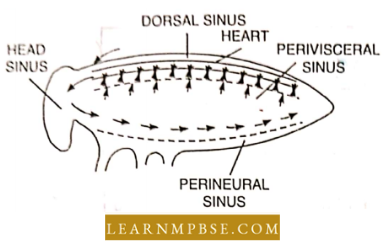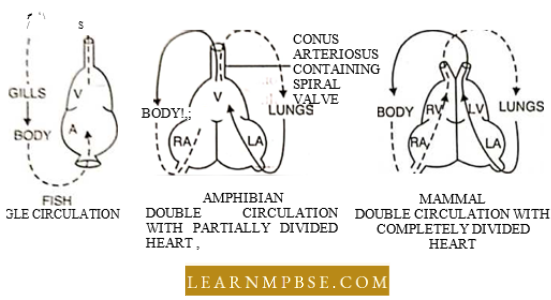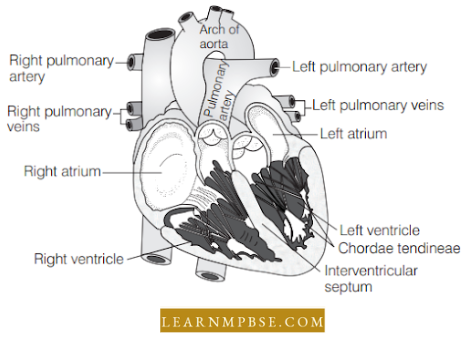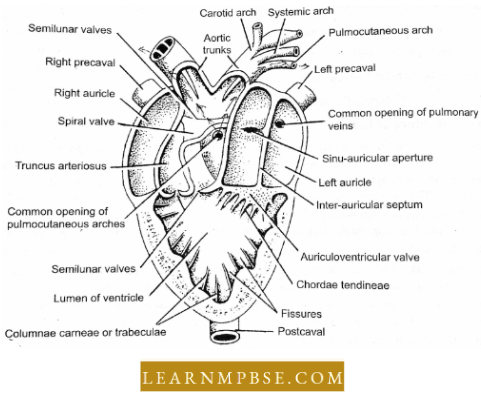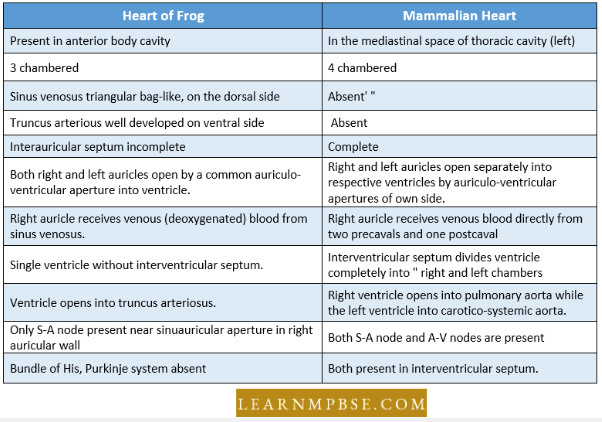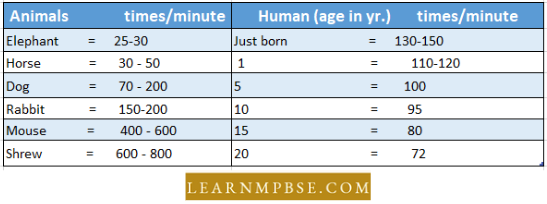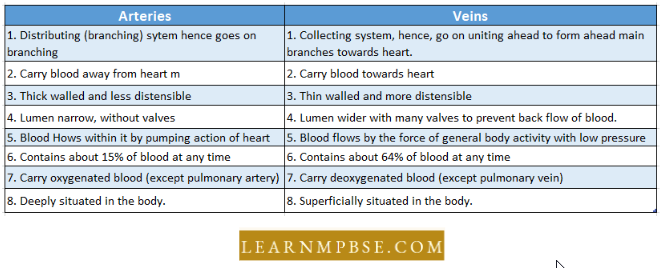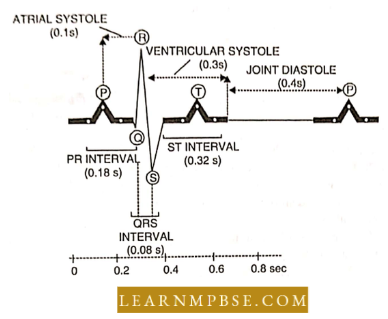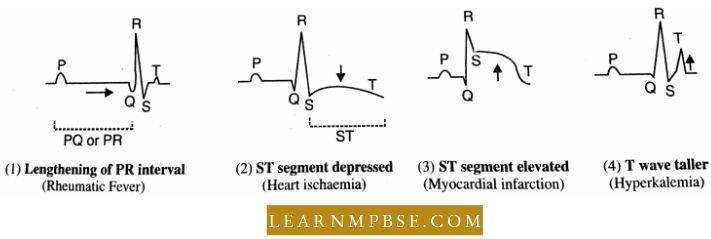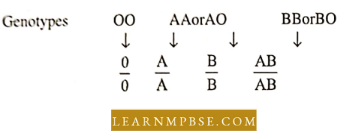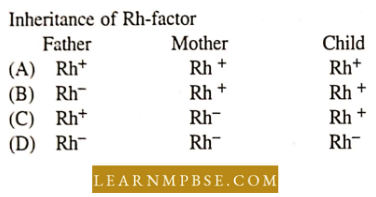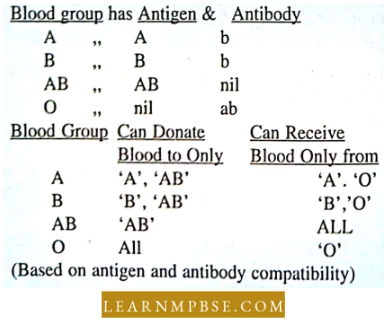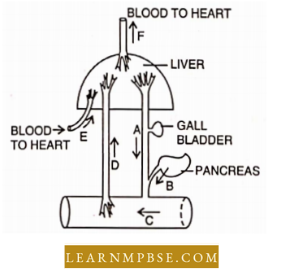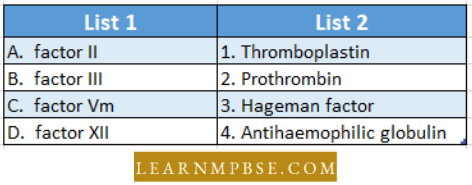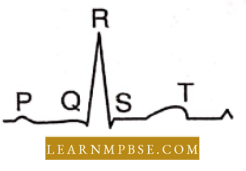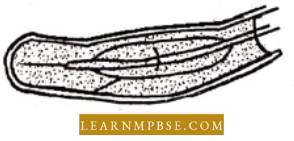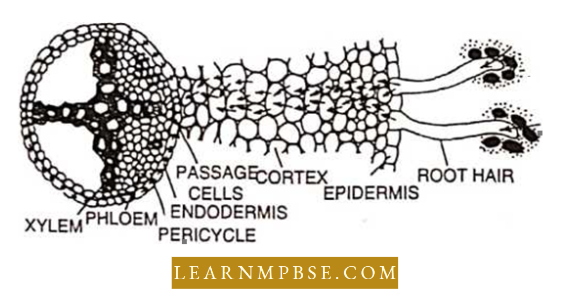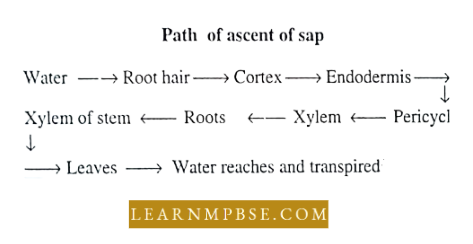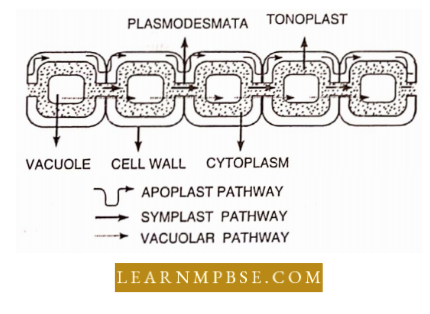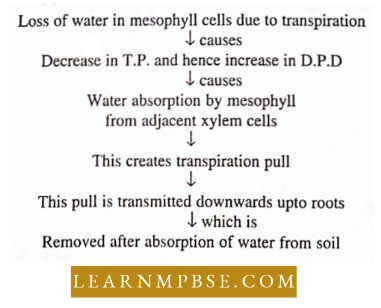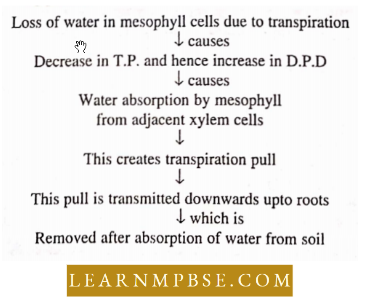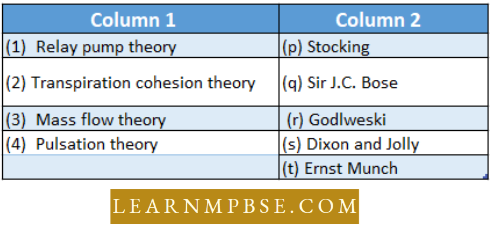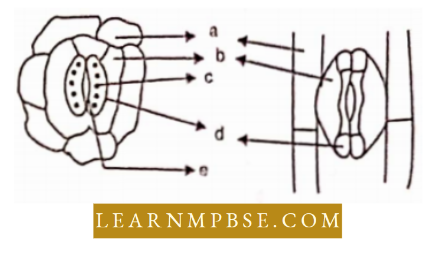NEET Biology Respiratory System In Animals
Respiration. It is an oxidising and energy-liberating phenomenon. It involves the intake of O2 enters the body, and oxidises the nutrients (Glucose) to form CO2 and H2O.
- Energy is liberated in steps and stored in high-energy phosphate bonds in ATP. CO2 thus formed is expelled out.
- Aerobic respiration. It is the common method of respiration. It is carried out in the presence of free molecular O2 in most plants and animals.
- Anaerobic respiration or anaerobic metabolism. It is mostly carried out by bacteria, and yeasts. RBC and endoparasites.It is a process of energy liberation in the absence of free O2.
External respiration. All animals require a medium for respiration.
- The gaseous exchange takes place between the external environment and blood through respiratory organs.
- External respiration is the exchange of gases between the air spaces of the lungs and blood in pulmonary capillaries.
- In external respiration, pulmonary capillary blood gains O2 and loses CO2.
- The percentage of oxygen in inhaled air is about 2.1 and the oxygen content of the air we expire is about 16.
- The carbon dioxide amount in the atmosphere is 0.033%, and carbon dioxide in the air we expire is about 3.6%.
Read and Learn More NEET Biology Notes
Internal respiration. Internal respiration is an exchange of gases between blood in systemic capillaries and tissue.
- When there is a difference in partial pressures, oxygen diffuses outward from the arterial end of capillaries into surrounding tissues.
- Carbon dioxide diffuses from the tissues into the bloodstream towards the venous end of capillaries.

- Modes of respiration. Cutaneous respiration. It occurs in the skin, For Example, Frog, or earthworm.
- Branchial respiration. It is carried out in aquatic animals and respiratory organs are gills For Example Fish, prawns, mussels, and tadpole larvae.
- Buccopharyngeal respiration. The lining of the buccopharyngeal cavity acts as a respiratory surface For Example Frog, Toad.
- Pulmonary respiration. It occurs in lungs For Example, amphibians, reptiles, birds, and mammals.
Respiration In Plants NEET Notes
Characteristics of the respiratory surface
- It should be extensive. Lager the surface area, the greater id the exchange of respiratory gases.
- It must be thin-walled, moist highly Vascular,
- It should Iv easily permeable to oxygen mid-carbon dioxide,
NEET Biology Respiratory System In Animals Respiratory Structures
Plasma Membrane. External respiration in (lie protists occurs principally by diffusion of oxygen-dissolved
in water and carbon dioxide in opposite directions through the plasma membrane.
Body Wall. In sponges, cnidarians, platyhelminths, annelids and small aquatic animals, respiratory gas exchange occurs through the diffusion of gases across the general body wall.
- In Hydra, gases are exchanged by diffusion between individual cells and the surrounding water.
- Earthworms have no special respiratory organs; they exchange O2 and CO2 using their entire Imdy surface.
Gills. Gills are the gas exchange organs of aquatic animals.
- Gill are an outgrowth of the body surface which is highly folded or convoluted to increase the surface area available for gas exchange,
- Aquatic animals like prawns (Crustacea), fishes and tadpoles respire with gills.
- Gases are exchanged between the surrounding aqueous medium and blood in the gill capillaries.
- Gills are best developed and understood in bony fishes.
- Gills consist of several gill arches from which extend two rows of gill filaments.
- Upon each filament are rows of gill lamellae, which is the site of gas exchange.
- Water and blood flow in opposite directions i.e. counter current.
- Water is moved over the gills by the pumping action of the mouth and the opercular cavity. A dual pump operates. endodermal outgrowth from the oesophagus, For Example, protopterus.
Trachea. Tracheal respiration occurs in insects.
- A well-developed system of ectodermal cuticular tubes called trachea open to the outside by 10 pairs of spiracles or stigmata on the dorsolateral margin of the tergum.
- Each spiracle is bounded by a peritreme, the spiracles open behind into the atrium (2 pairs thoracic and 8 pairs abdominal).
- There are 6 main trunks connected through commissures.
- It branches distally into tracheoles (without cuticular rings) within a tissue or the cell known as the transition or stellate cells or tracheoblasts.
- The trafficking of air through spiracles is guided by valves. Most of these (all abdominal) spiracles remain closed during expiration to prevent the loss of water from the body.
- Spiracles can be opened or shut.
- Gas exchange takes place in the walls of tracheoles.
- Insects have blood, but it is not important in gas transport, since the tracheal system spreads throughout the body.
Book Lungs. Booklungs are respiratory organs in arachnids like scorpions.

Respiration In Fresh Water Fishes (Labeo). Respiration in Labeo is aquatic, the fish depend on O2 dissolved in water.
Glycolysis And Krebs Cycle NEET Study Material
Respiratory organs. Labeo respires with 4 pairs of filiform gills supported by the first 4 pairs of gill arches. Four gills are present on either side of the pharynx in a common gill chamber.
- Each gill chamber is covered externally by a skin flap, the operculum, supported by bony plates. A branchiostegal membrane is attached to the posterior margin of the operculum.
- The chamber opens to the outside by a large crescentic branchial or gill aperture behind the operculum and in front of the pectoral fin. Each gill consists of two rows (hemibranchs) of slender gill filaments.
- In Labeo and other teleosts, the filaments are attached to an extremely reduced interbranchial septum so that their distal ends hang freely in the gill chamber. This type of gill is called filiform or pectinate.
- In contrast, the gills of dogfish and other elasmobranchs are called lamellibranchs in which the gill lamellae are attached throughout their length to an elongated septum.
- Every gill filament bears several minute transverse plates or lamellae covered with thin epithelium and containing capillaries between the afferent and efferent branchial arteries.
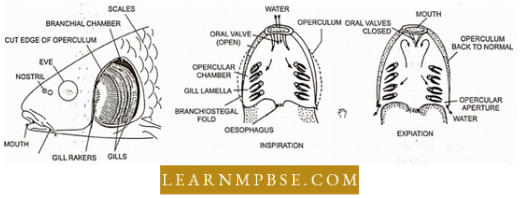
Mechanism of respiration. Breathing movements occur in two steps, the gill chambers working as suction pumps.
- Inspiration. During inspiration, opercula and branchiostegal membranes press against the body keeping the two external branchial apertures tightly closed.
- The gill arches bulge laterally enlarging the internal capacity of the bucco-pharyngeal cavity which acts like a suction pump. As a result, the oral valves open and water flows in through the opened mouth to fill the bucco-pharyngeal cavity.
- Expiration. Now the oral valves close shutting the mouth, the gill arches contract and the opercula and branchiostegal membranes lift, opening the external branchial apertures.
- Consequently, water under pressure is forced to pass over gill filaments and out through the external branchial apertures.
- Physiology of respiration. The afferent branchial artery bringing deoxygenated blood breaks up into capillaries into lamellae of gill filaments where the exchange of gases occurs by osmosis through their thin walls.
- As first respiratory Water passes over gill filaments, their blood gives up CO2, and absorbs O2, from water. The efferent branchial artery carries away oxygenated blood from the gill to the body. it soon needs a constant supply of fresh O2-bearing water for life.
- If water is depleted of O2 or fish is removed from the water, it soon dies due to lack of oxygen, called asphyxiation.
NEET Biology Respiratory System In Animals Respiration In Frog
Amphibians such as frogs carry out:
- Cutaneous respiration
- Buccopharyngeal respiration
- Pulmonary respiration
- During hibernation (winter sleep), frog respires with the help of moist skin only.
- In frogs, skin is seen as an accessory organ of respiration.
- In frogs, cutaneous respiration takes place always.
- The lungs of frogs are spongy masses of tissues.
- Compared to a mammal, pulmonary respiration of a frog is not very efficient.
- In frogs, the diaphragm is absent and is not related to respiration.
- Contraction of sternal muscle during breathing in frogs lowers the floor of the buccopharyngeal cavity.
- Contraction of propyl muscle during breathing in frogs raises the floor of the buccopharyngeal cavity.
- The epithelial lining of the alveoli of a frog’s lung-facing lung cavity is columnar and ciliated.
- During pulmonary respiration of a frog, the mouth remains closed.
- In frogs, the glottis is controlled by the muscle of the arytenoid cartilage.
NEET Biology Respiratory System In Animals Respiratory Organs of Human
The respiratory system is derived from the ectoderm. It consists of the respiratory tract and respiratory organs (lungs)
Nasal Chamber. Nasal chambers communicate to the exterior by two openings called nostrils or external nares (separated by mesethmoid bone); a cavity inferior to the cranium and superior to the mouth; internally (posteriorly) opens in the pharynx through two internal nares.
- Four paranasal sinuses called frontal, sphenoidal, maxillary and ethmoidal along with nasolacrimal ducts open into the nasal chamber.
- Ethmoid bone forms the roof and palatine maxilla and hard palate forms the floor of the nasal chamber.
- A vertical nasal septum divides the anterior part of the nasal cavity into right and left vestibules surrounded by cartilage and lined with coarse hairs to filter dust particles.
- The posterior cavity has projections of superior, middle and inferior conchae or turbinal bone and is lined with the mucous membrane.
- The superior part of the cavity has an olfactory region lined with a Schneiderian membrane. Below it, there is the lining of pseudostratified cells which also secrete mucus.
- As the air passes around and over the turbinal, it is wanned or cooled and disinfected and the moistened mucus traps the dust particles. Thus breathing through the nose is always preferred to breathing through the mouth.
NEET Biology Respiratory System In Animals Pharynx
- It is 13 cm long, starting with the soft palate area representing the crossing point of the air route and food route. Uvula, the free posterior and muscular part of the soft palate divides it as the anterior oropharynx and posterior nasopharynx.
- The nasopharynx is (ho posterior part of the pharynx behind the nasal cavity. Tltcrc openings in its walls, two internal narcs and two openings or Eustachian tube.
- The lower part of the pharynx is called InrynRophnrynx extends down the hyoid bone, and opens into the oesophagus(gullet) and larynx (glottis) anteriorly; lined with stratified squamous epithelium.
NEET Biology Respiratory System In Animals Larynx Voicebox
- The upper part of the trachea makes a cartilaginous box with a pair of arytenoid cartilage and three single cartilage pieces: thyroid cartilage, cricoid cartilage and epiglottis. The other two supporting cartilages are corniculate and cuneiform.
- Adam’s apple in males is formed by enlargement of thyroid cartilage due to the effect of male sex hormones after puberty. The epiglottis acts as a valve over the glottis.
Trachea (windpipe). A tube of about 6 cm in length and 2.5 diameters supported with dorsally incomplete (C-shaped) rings of hyaline cartilage.
- The trachea lies mainly in the median plane anterior to the oesophagus.
- The cartilages are incomplete posteriorly and even when there is no air, the trachea does not collapse due to the presence of incomplete ‘C’ shaped cartilaginous rings (tracheae of cockroaches also have non-collapsible walls).
- The mucosa of the trachea is lined with a ciliated pseudostratified epithelium containing mucus-secreting goblet cells and this helps in pushing mucus out.
- Bronchi: In the thorax, the trachea divides into the right and left primary bronchus with the cartilaginous ring.
- Within the lungs, it branches into bronchioles—primary, secondary and tertiary (or terminal) bronchioles leading to alveoli. Bronchioles are without cartilaginous rings.
Electron Transport Chain In Plants NEET Important Points
NEET Biology Respiratory System In Animals Lungs The Respiratory Organs
These are paired, cone-shaped, spongy organs in the thoracic cavity enclosed within the pleural cavity. The outer pleuron attached to the wall of the thoracic cavity is called the parietal pleura and the inner layer is called the visceral pleuron.
- The two layers of pleura are separated by a thin pleural cavity, filled with a small amount of pleural fluid secreted by epithelial cells.
- The space between the right and left pleural cavities is the mediastinum.
- The trachea lies mainly in the median plane anterior to the oesophagus.
- The mucosa of the trachea is lined with a ciliated pseudostratified epithelium containing mucus-secreting goblet cells and this helps in pushing mucus out.
- The right and left lungs are divided into three and two lobes respectively.
- The left lung contains a concavity called the cardiac notch in which the heart lies.
- The right lung is thicker and broader but shorter than the left lung because the diaphragm is higher on the right side to accommodate the liver lying below it.
- Terminal (or respiratory) bronchioles divide to form many alveolar ducts or atria with many alveoli around.
- Each lung is a blunt cone; the tip or apex points superiorly.
- The broad inferior portion or base of each lung rests on the superior surface of the diaphragm.
- The lungs possess distinct lobes that are separated by deep fissures.
- In man, the right lung has three lobes; superior, middle and inferior, separated by the horizontal and oblique fissures.
- The left lung has only two lobes superior and inferior, separated by the oblique fissure.
- Medially, the left lung contains a concavity, the cardiac notch, in which the heart lies.
- Branches of pulmonary artery supply deoxygenated blood to each lung.
NEET Biology Respiratory System In Animals Diaphragm
The diaphragm (dia, across; phragm, wall) is characteristic of mammals.
- The diaphragm is a dome-shaped muscular structure separating the thoracic and abdominal cavities.
- The diaphragm forms the floor of the thoracic cavity and the roof of the abdominal cavity.
- The diaphragm is composed of a peripheral muscular portion mid a central portion called the central tendon.
- The most important function of the diaphragm of mammals is to aid in respiration.
- Puncturing of the diaphragm results in a stoppage of breathing and is fatal.
- The term ‘phrenic’ is associated with the diaphragm.
- The diaphragm is supplied by the phrenic nerves.
NEET Biology Respiratory System In Animals Mechanism Of Respiration
- The process is completed in three steps breathing, pulmonary ventilation and transport of gases in blood.
- Breathing (Pulmonary ventilation). It means inflow (inspiration) and outflow (expiration) of air
- Breathing is affected by the expansion and contraction of the lungs. Since the lung capillaries are constantly removing oxygen from the air and putting carbon dioxide in the alveoli, the need for replacing the air in the lungs is obvious.
- If a normal breath consists of about 500 ml of air, this could be multiplied by 16 to yield a volume of about 8 litres per minute.
- In human beings and other mammals the ribs, chest muscles (intercostal) and diaphragm are easily movable and the volume of the chest cavity can be increased or decreased at will.
- The downward and upward movement of the diaphragm lengthens and shortens the chest cavity. At the floor of the chest cavity, the diaphragm, contracts decreasing its convexity and consequently enlarging the cavity.
- Because the space is closed, this increase in volume results in a lowering of the pressure in the lungs, and when it falls below atmospheric pressure air from the outside rushes in through the trachea and its branches to the air sacs and alveoli.
- The elevation and depression of ribs increase or decrease the diameter of the chest cavity. During inspiration, the rib muscles contract, drawing the front ends of the ribs upward and outward, an action made possible by the hinge-like connection of the ribs with the vertebrae.
- During inspiration the lungs are distended as they are filled with air, when the rib muscles relax, the ribs are permitted to return to their original position and the simultaneous relaxation of the diaphragm permits the abdominal organs to push it back up to its previous convex shape.
- These factors decrease the chest cavity and allow the distended elastic lungs to contract and expel the air which had been inhaled.
- In big and heavy animals, the diaphragm plays a more important role than the ribs (elephants), on the other hand, jumping animals like kangaroo and monkeys utilize rib muscles rather than the diaphragm in breathing.
- Breathing using ribs is believed to the relatively more pronounced in human females than in males.
- This difference in respiratory mechanism is merely an adaptation brought about by pregnancy during which period the presence of a growing foetus interferes somewhat with the freedom of the movement of the diaphragm.
- During inspiration the alveolar pressure falls below atmospheric one so air rushes in and during expiration, alveolar pressure goes above the atmospheric pressure and thus air goes out. Thus normal breathing is negative pressure breathing.
- Lungs act as suction pumps
- During the exhalation of air or expiration, the diaphragm relaxes and the lungs are compressed.
- During exhalation, the capacity of the thoracic cavity decreases due to inward as well as downward movement of rib cages as well as inward movement of the diaphragm.
- During exercise rate of breathing increases (Exchange and transport of gases are discussed separately).
NEET Biology Respiratory System In Animals Exchange Of Gases
- Exchange of Gases. Between the process of inspiration and expiration, the interchange of aspirating gases occurs.
- This interchange takes place between the blood of the capillary network which suspends the alveoli and the air in the alveoli of the lungs.
- In external as well as internal respiration, gases always tend to diffuse from high partial pressure to low partial pressure i.e., down the concentration gradient.
- The Pressure of gases in the Wood is usually expressed as gas tensions, (Partial pressure) The oxygen tension in alveolar air lOOmm of Hg. Oxygen tension in venous blood = 40mm Hg. A pressure difference of 60mm of Hg serves to drive Oxygen from the alveoli of the lung into the blood.
- The CO2 tension in alveolar air = 40 mm Hg CO2 census venous blood = 46 mm of Hg. A relatively small difference of 6 nun flag is sufficient to drive CO2 from the blood into the lung.
- During internal respiration i.e. interchange of gases between the tissue and the blood takes place. The physical basis of gas diffusion is the same i.e., down the concentration gradient.
Respiration In Plants NEET Mcqs With Answers
NEET Biology Respiratory System In Animals Transport Of Gases
Transport of Oxygen by Blood
- Oxygen is transported in the blood by a respiratory pigment, haemoglobin, which is a conjugated protein.
- Haemoglobin consists of a large protein molecule, the globin consisting of four polypeptide chains (two a and two p chains) each of which attached a prosthetic heme group. Heme is based on a structure known as porphyrin ring structure which includes four pyrol groups around a central Fe.
- The transport of oxygen by the blood from the lungs to the tissues is mainly due to the ability of haemoglobin to combine reversibly with oxygen. Since one molecule of haemoglobin has four heme groups, and each Hb molecule is capable of taking up four molecules of O2.
- Haemoglobin is dark red whereas oxyhaemoglobin is bright red. Oxyhaemoglobin on reaching the tissue dissociates into free O2 and haemoglobin. Again O2 diffuses into tissue because of the difference in partial pressure.
Transport of CO2 from tissues to lungs
- A small amount of CO2 is transported in a dissolved state in the plasma of blood.
- About 70% of CO2 produced enters R.B.C. by diffusion. Each decilitre (100 ml) of blood receives 3.7 ml of CO2 from tissue and the rest of the CO2 diffuses into blood plasma to form carbonic acid with water.
- CO2 is also transported as carbamino-haemoglobin (reduced haemoglobin) inside R.B.C
NEET Biology Respiratory System In Animals Haldane Effect
- Oxyhaemoglobin behaves as a strong acid and as more and more oxyhaemoglobin is formed, it releases more H+ ions which decreases the pH of blood.
- Role of haemoglobin in the transport of oxygen from lungs to tissue
- In a normal healthy person, there is about 15 gm of Haemoglobin per 100 ml of blood.
- The capacity of 1 gm of Hb to combine with oxygen is 1.34 ml. Thus on average, 100 ml of blood transports 20 ml (19.4) ml of oxygen.
- When oxygen diffuses into the blood in external respiration most of it enters the red blood or erythrocytes and unites with the haemoglobin in these cells forming a compound called oxyhaemoglobin.
- Haemoglobin is a complex protein compound containing iron which has a great affinity for oxygen. This property of haemoglobin enables the blood to carry about 50 times more oxygen than the plasma alone can carry.
- As the blood passes through the alveolar capillaries, the haemoglobin becomes saturated with oxygen. This reaction may be represented as follows :
- Oxyhaemoglobin is a very unstable compound and, when the blood reaches the capillaries in the tissue, throughout the body where the oxygen tension is low, the compound breaks down into haemoglobin and oxygen and the oxygen diffuses into the cells.
- The reaction which occurs in the tissue capillaries may be indicated in the following way:
- Hb + O2→HbO2
- Oxyhaemoglobin has a bright scarlet colour while reduced haemoglobin has a dull purplish colour. This counts for the difference in colour between arterial and venous blood.
Role of carbonic unitydruse enzyme In the transport of gases during respiration. Carbonic is an enzyme found in the erythrocytes. It takes part in the joining of CCK with water to form Carbonic acid. It is completed in less than one second.
- HbO2→Hb + O2
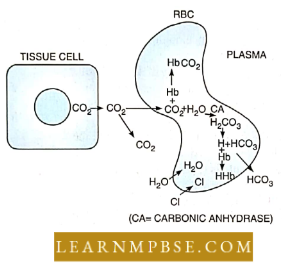
NEET Biology Respiratory System In Animals Hamburger’s Phenomenon
- When whole blood is saturated with CO2. the following changes are commonly seen :
- The bicarbonate content of plasma and corpuscle is increased.
- The chloride (Cl‾) of plasma is diminished and that of the cells (RBCs) is increased.
- The total base (cation) of both corpuscles and plasma remains unchanged.
- Water content and the volume of CO2 are increased in blood.
But when CO2 is removed from the blood, reverse changes occur. Now it is evident that when CO2 enters blood, chlorine from plasma enters the RBC while Na is left behind. When CO2 escapes from the blood, Cl‾ leaves the cells, enters the plasma and combines with the base Na. Due to this alternate movement of Cl‾, this phenomenon is called the chloride shift
NEET Biology Respiratory System In Animals Haemoglobin
- The oxygen carrier or respiratory pigment in the blood of vertebrates is haemoglobin.
- Haemoglobin is a protein (5% haeme and 95% globin), its molecule is made up of four polypeptides, two -chains and two chains.
- The O2 dissociation curse for Myoglobin is rectangular hyperbola.
- Each of the four chains is linked to a prosthetic group: iron-containing Heme group with the amino acid histidine acting as the linker site.
- The total molecular weight, of haemoglobin, is 34.000.
- Here is the respiratory carrier part and each unit contains a central iron atom which is in the ferrous (Fe+ +) state.
- It is this iron atom that combines with oxygen.
- The metal constituent of haemoglobin is iron.
- One molecule of haemoglobin can carry as much as four oxygen molecules.
- The chemical formula of oxyhaemoglobin is Hb(O2)4.
- A normal person has bout 15 grams of haemoglobin per 100 rnL of blood.
- One gram of haemoglobin binds about 1.34 mL of O2. Thus, 100 tnL of pure blood carries about 20 mL of oxygen.
- Oxygen is transported from the lungs to the tissues combined with Hb rather than dissolved in blood plasma.
- The oxygen content of blood leaving the lungs is greater than that of blood entering the lungs.
- The blood coming out of the lungs is richer in oxygen than of blood entering the lungs.
- 100 mL of oxygenated blood contains only about 1.5% oxygen dissolved in plasma. The remaining 98.5% is carried in the form of HbO2.
Respiration In Plants NEET Previous Year Questions
NEET Biology Respiratory System In Animals Oxygen Dissociation Curve
Normally haemoglobin (respiratory pigment) combines with oxygen. Each iron atom of the iron porphyrin ring complex can attach with one molecule of O2 and when all the sites are occupied, the haemoglobin cannot take on any more since it is fully loaded or saturated.
- This situation varies greatly. In other words, the proportion of oxyhaemoglobin to haemoglobin present in the blood at any time is dependent upon the tension of O2 in the blood. This is known as the dissociation curve of haemoglobin.
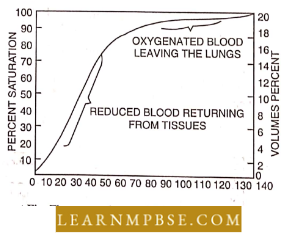
In this way, the actual relationship between the partial pressure of O2 and the degree of saturation of haemoglobin with O2 can be shown by the remarkable oxygen haemoglobin dissociation curve.
Shifting Of Oxyhaemoglobin Dissociation Curve
- In all the following conditions the dissociation curve (Sigmoid-shaped) shifts to the right-hand side and the affinity of haemoglobin for oxygen decreases to release or dissociate more oxygen to the tissues.
- When the concentration of carbon dioxide increases (CO2, conc.↑↑)
- When temperature increases (Temp.↑ )
- When acidity increases or pH decreases (acidity↑)
- When altitude increases (Altitude↑)
- When amount of2, 3 DPG (Diphosphoglyceraldehyde( increases in RBCs (2, 3 DPG).
- When conditions are opposite, the curve shifts to the left-hand side.
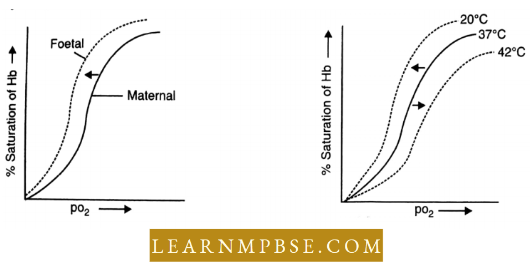
Bohr’s Effect. When the pH of the blood decreases (acidity increases) the p50 value increases and the affinity of haemoglobin for oxygen decreases. This effect or law is called Bohr’s effect.
NEET Biology Respiratory System In Animals Breathing Control
Breathing control. Breathing is regulated through nerve impulses and chemical impulses.
Nervous control. Russian Scientist N. Mislavsky (1885) reported that the Respiratory centre (inspiratory and expiratory) is located on the floor of the medulla oblongata and pneumonitis centre in pons Varolii.
- From this centre impulse is transmitted via the phrenic nerve to the diaphragm and rib muscles which then contract and enlargement of alveoli stimulates stretch receptors, and the impulse is transmitted by the vagus nerve back to the medulla, stopping the impulse of the phrenic nerve.
- The muscles relax, reducing the cavity and the body exhales. The process is repeated. However, forced breathing is under the control of the cerebrum.
Chemical control. Kussumal and Tenner postulated that the venosity of blood of cerebral circulation also influences respiration. A chemical-sensitive area located close to the respiratory centre in the medulla maintains the proper concentration of O2, CO2 and H+ in the blood and body fluid. It is sensitive to changes in CO2 or pH in blood although the oxygen content is hardly changed.
Hering Breurer reflex. Located in the walls of bronchi and bronchioles are certain centres. They are stimulated when the lungs are overstretched and transmit impulses through the vagus nerve to the respiratory centre. It serves as a protective mechanism for preventing lung inflation.
Bohr effect. Changes in CO2 concentration in the blood greatly affect the oxygenation of blood in the lungs as well as the release of O2 from the blood in the tissue because deoxygenation of haemoglobin is directly proportional to the CO2 of blood. It is called Bohr’s effect.
According to this effect, as blood passes through the lungs, CO2 readily. diffuses from it into the alveoli. This reduces blood CO2 and increases its pH. Both these changes make the media unsuitable for deoxygenation but suitable for oxygenation of haemoglobin. Hence, these enhance the binding of more and more O2 with haemoglobin.
NEET Biology Respiratory System In Animals Pulmonary Air Volumes
- Pulmonary air volume. It is because of the pressure gradient that the air flows into and out of the lungs. The amount of air exchanged during breathing is measured by an apparatus called a spirometer.
- The following terms explain various pulmonary air volumes. Tidal volume (TV). The amount of air that flows in and out of the lungs with each respiratory movement at rest. (500 ml in adults).
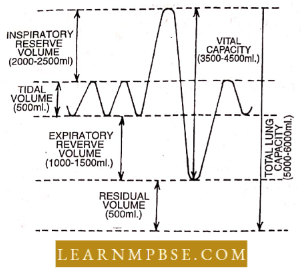
- Inspiratory reserve volume (1RV). The volume of forced inspired air in addition to normal inspired air (tidal volume) is called inspiratory reserve volume. (About 2000-2500 ml).
- Expiratory reserve volume (ERV). The volume of air that expires forcefully in addition to normal expired air is called expiratory reserve volume (About 1000 ml).
- Residual volume (RV). The volume of air left in the lungs and respiratory passage is called residual volume (1500 ml).
- Vital capacity. The quantity of air that a person can expel by forcible exhalation after the deepest inhalation (4000 ml in adult man).
- Total lung capacity. It is the total of vital capacity and residual volume. (5 to 6 litres).
- The combinations of specific lung volumes are termed lung capacities. Four lung capacities are :
- Inspiratory Capacity (IC) is the sum of tidal volume and inspiratory reserve volume (500 + 3100 = 3600 mL).
- Functional Residual Capacity (FRC) is the sum of residual volume and expiratory reserve volume (1200 + 1200 = 2400 mL).
- Vital Capacity (VC) is the sum of inspiratory reserve volume, tidal volume and expiratory reserve volume (3100 + 500 + 1200 = 4800 mL).
- Total Lung Capacity (TLC) is the sum of the vital capacity and residual volume (4800 + 1200 = 6000 mL).
Respiration In Plants NEET Exam Preparation
NEET Biology Respiratory System In Animals Protective Response Of Respiratory System
- Coughing. Coughing results from irritation of the larynx, trachea and bronchi caused by smoking and allergy to dust and pollen. It involves deep inspiration, closure of vocal cords, and violent expiration due to vigorous contractions of abdominal muscles accompanied by sudden gaping of vocal cords.
- Sneezing. Spasmodic contraction of muscles of expiration forcefully expels air through the nose and mouth. Stimulus may be an irritation of the nasal mucosa. It involves a deep inspiration (“ah”) and a violent expiration (“…… choo”) through the nose and mouth.
- Shut Down. When air containing noxious chemicals, such as acid vapour, is inhaled, the respiratory system is momentarily shut down.
Respiratory Disorders
- Hypoxia. Lack of O2 in body fluids is called hypoxia.
- Artificial Hypoxia. It results from a shortage of oxygen in the air at high (over 2400 m.) altitudes. It causes mountain sickness characterised by breathlessness, headache, dizziness, nausea, vomiting, mental fatigue and a bluish tinge on the skin and mucous membranes.
- Anaemic Hypoxia. It results from the reduced oxygen-carrying capacity of the blood due to anaemia (decreased haemoglobin content in blond) or carbon monoxide poisoning (some haemoglobin occupied by CO). In both cases, less haemoglobin is available for carrying O2
- Histotoxic hypoxia. It is oxygen deficiency at the tissue level caused by cyanide poisoning which inactivates the enzyme system of the electron transport chain or cells,
- Emphysema. It is a disorder of the lungs as they lose their elasticity and permanently get distended.
- Asphyxia (suffocation). The O, content of blood falls whilst the CO, content rises and paralyses the respiratory centre. Breathing stops and detail occurs.
- Orthopnea. Inability to breathe in a horizontal position.
- Hypercapnia. It means excess of CO2 in the body fluids.
- Pleurisy (plcuritis). Inflammation of pleural membranes.
- Epistaxis. It is the nose bleeding.
- Cyanosis. It means blueness of the skin and its cause is an excessive amount of deoxygenated haemoglobin in the skin’s blood vessels.
- Bad cold. Disease-causing microbes present in the air attack the respiratory tract, producing inflammation of the mucous membrane in various regions and increased secretion
- Rhinitis in the nasal chambers;
- Sinusitis in the sinuses;
- Pharyngitis in the pharynx, often called sore throat, is usually accompanied by tonsillitis (enlargement of tonsils);
- Laryngitis in the larynx, causes a hoarse voice and difficulty in speaking.
- Bronchitis in the bronchioles;
- Pneumonia. The disease of the lungs and respiratory tract is caused by the bacterial infection Diplococcus pneumoniae. It results in a deficiency of 02 as these organs get clogged.
- COPD. Chronic Obstructive Pulmonary Disease which includes Emphysema, Chronic bronchitis and Asthma.
- Whooping cough or Pertussis. An infectious disease caused by the bacterium Bordetella pertussis.
- Asthma – Difficult breathing due to spasms in branchial muscles and narrowing of bronchi.
- Sleep Apnoea Syndrome (SAS). Persons with snoring habit suffer from sleep apnoea syndrome because their upper respiratory tract closes on inhalation leading to apnoea and sleep breaks.
- Atelectasis. Mean collapse of alveoli. Lack of surfactant also leads to atelectasis.
- Pleuritis – Inflammation of pleural membrane.
NEET Biology Respiratory System In Animals Larynx
It is also called a voice box or Adam’s apple. It is a small, wide, thin-walled, tubular chamber present at the beginning of the neck. It is more developed in males after attaining puberty so they have a deeper voice. It is supported by four cartilages
- Thyroid cartilage. It is the largest sized and C – C-shaped cartilage which supports the anterior and lateral sides of the upper part of the larynx.
- The posterior border of each lamina gives two processes- superior and inferior cornu while the ventral side of its anterior part gives a bilobed cartilaginous process called epiglottis to close the glottis during swallowing.
- Arytenoids. These are two smallest-sized, pyramid-shaped cartilages which support the posterior wall of the upper part of the larynx.
- Cricoid. It is a ring-shaped cartilage which completely supports the lower part of the larynx. Within the larynx, there are two yellow fibrous folds called vocal cords extending between the arytenoids and thyroid cartilages.
- Vocal cords are longer in males (about 2-3 ) than in females (about 1.7 cm). Each vocal cord is covered by a stratified squamous epithelium. Between two vocal cords, there is a slit-like glottis which is usually open to allow the unobstructed supply of air but can be closed by epiglottis during swallowing.
- Vocal cords can be stretched or relaxed, and the size of the glottis can be changed with the help of the Laryngeal muscle.
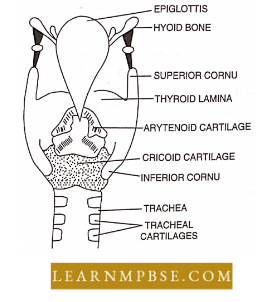
- Certain small amphibians, such as Plcurodont salamander have no lungs and respire only by skin.
- Respiratory quotient. The ratio of the volume of carbon dioxide evolved and oxygen consumed during a given period of respiration is termed respiratory quotient (R.Q.).
- Sachs (1890) discovered anaerobic respiration. Hacmocynnin is blue-coloured when oxygenated and colourless when deoxygenated.
- The trachea of man is supported by “C” shaped cartilaginous rings and that of insects by conidia (spiral cuticular) lining. In some turtles, the cloaca acts as a respiratory organ.
- The respiratory centre is situated in the medulla oblongata of the man.
- Forced breathing is regulated by the cerebrum. The dissociation curve is associated with haemoglobin. Annelids (mostly earthworms) have two respiratory pigments i.e. haemoglobin and erythrocruorin. The breathing rate increases with an increase in the body temperature of a man.
- Rats have the highest metabolic rate.
- Decompression sickness is also known as Caisson Disease or Diver paralysis.
- Molpadin respiratory pigment occurs in Molpadia. Examples: Class Holothuroidea of phylum echinodermata.
- Philip Drinker, an American Engineer invented a tank respirator or iron lung in 1929.
- Turbinals (nasal conchae) are derived from nasals, maxillae and ethmoids.
- The diaphragm forms the concave surface of the floor of the thoracic cavity and the convex surface of the abdominal cavity.
- The diaphragm plays a 75% part in abdominal breathing.
- The diaphragm is supplied with blood by the phrenic artery.
- The diaphragm is innervated by the phrenic nerve.
- Ribs and sternum play a 25% part in breathing, i.e. thoracic breathing.
- Chloride shift is also called Hamburger’s phenomenon.
- A swim bladder is not found in flatfishes.
- A slug (a mollusc) is purely an air breather.
- Zinc is a constitutent of enzyme carbonic anhydrase.
- The haemoglobin of the foetus has a higher affinity for oxygen than the mother’s haemoglobin.
- Vocal cords in the larynx are attached to the arytenoid cartilage.
- Cartilage of Santorini. It is the band at the apex of the arytenoid cartilage.
- In the larynx, the cartilages present are thyroid cartilage (largest), cricoid cartilage, and arytenoid cartilage.
- The wall of the alveoli is lined by squamous epithelium.
- In frog respiration = Cutaneous : 35% + Buccopharyn- cs> gcal: 9% + Pulmonary : 56%
- Water lungs are present in the holothuria of chinodermata.
- In some marine annelids such as sandworm [Nereis] the locomotory appendages called parapodia are adapted for the exchange of gases.
- Prawn has 8 pairs or rows of gills while common carp (Labeo) has 4 pairs of gills.
- The counter-current flow of blood and water in the gills maximises the absorption of oxygen.
- Peripatus breathes through the trachea.
- Breathing with the help of ribs is more pronounced in females.
- About half a litre of water goes out during expiration per day.
- During single circulation, only 25% of haemoglobin gives up oxygen.
- Larvae of urodeles and anurans draw a current of water through the nasal chamber, Marine turtles snakes, and many land lizards have salt-secreting- nutria! gland anterior and median to Jacobson’s organ, They remove NaCl from the body.
- In Kiwi, the external nares lie almost at the tip of the beak.
- Marine birds such as herring gulls, pelicans, cormorants etc. have salt glands that supplement in excreting NaCl.
- Visceral pouches called gill pouches, branchial pouches or visceral clefts put the pharynx in communication with the exterior. The openings of branchial pouches into the pharynx are known as internal gill slits and those to the exterior as external gill slits.
- The skin of certain fishes carries on respiration For Example. Periopthalmia, goggle-eyed fishes of India.
Respiration In Plants NEET Exam Preparation
NEET Biology Respiratory System In Animals Questions from Competitive Examinations
Question 1. Which of the following cells do not respire :
- Epidermal cells
- Erythrocytes
- Sieve Cells
- Conical cells.
Answer: 2. Erythrocytes
Question 2. Which of the following represents Adam’s apple?
- Thyroid cartilage of larYnx
- Arytenoid cartilage of larynx
- Cricoid cartilage of larynx
- All of the above.
Answer: 1. Thyroid cartilage of larYnx
Question 3. What is the amount of oxygen absorbed by one gram of haemoglobin?
- 135 ml
- 13.4 ml
- 1.34 ml
- 20 ml.
Answer: 3. 1.34 ml
Question 4. What is called insufficiency of O2?
- hypoxia
- xeroxia
- angina
- cough.
Answer: 1. hypoxia
Question 5. Tidal volume is :
- 5000 ml
- 1000 ml
- 500 ml
- 800 ml.
Answer: 3. 500 ml
Question 6. R.Q. is infinite in :
- aerobic respiration
- anaerobic respiration
- carbohydrates
- None of these.
Answer: 2. anaerobic respiration
Question 7. The end products of fermentation are :
- ethyl alcohol and CO2
- ethyl alcohol and O2
- methyl alcohol and CO2
- methyl alcohol only.
Answer: 1. ethyl alcohol and CO2
Question 8. CO2 is carried mainly in the form of:
- bicarbonates
- carboxy haemoglobin
- plasma
- none of the above.
Answer: 1. bicarbonates
Respiration In Plants NEET Syllabus Topics
Question 9. The air that enters our lungs :
- Is warm
- Is filtered
- Some oxygen is extracted
- Some CO2 is added.
Choose The Correct Option
- A, B, C, D
- B and D
- A and B
- C and D
Answer: 2. B and D
Question 10. The exchange of gases in the lungs is by :
- Simple diffusion
- Active transport
- Passive transport
- Osmosis
Answer: 1. simple diffusion
Question 11. Artificial respiration at the rate of 10-15 times per minute is being given to a man saved from drowning. This is because :
- Water in the respiratory passage is cleared fast at this rate
- Choking is least at this rate
- It is a normal rate of respiration
- Lungs are ventilated best at this rate.
Answer: 4. Lungs are ventilated best at this rate.
Question 12. Pasteurization of milk means that :
- All bacteria are killed
- Pathogenic bacteria are killed
- Milk is enriched with vitamins
- Milk casein is partially digested.
Answer: 1. All bacteria are killed
Question 13. In which one of the following do the two names refer to the same thing?
- Tricarboxylic acid cycle and citric acid cycle
- Citric acid and Calvin cycle
- Tricarboxylic acid cycle and urea cycle
- Krebs cycle and Calvin cycle,
Answer: 1. Tricarboxylic acid cycle and citric acid cycle
Question 14. What is the coned sequence of air passage in man?
- Nasal cavity→ pharynx→ larynx → trachea → bronchi → bronchioles → alveoli
- Nasal cavity → larynx-→ bronchi→ pharynx → trachea → bronchioles→ alveoli
- Nasal cavity → larynx → pharynx → trachea→ bronchi→ bronchioles→ alveoli
- Nasal cavity → pharynx → trachea → larynx → bronchi→ bronchioles→ alveoli.
Answer: 1. Nasal cavity -→ pharynx → larynx→ trachea→ bronchi → bronchioles→ alveoli
Question 15. When protein is aerobically oxidised, the R.Q. value will be :
- One
- Zero
- More than one
- Less than one.
Answer: 4. Less than one
Question 16. During expiration, the diaphragm becomes :
- Normal
- Flattened
- Dome-shaped
- Oblique.
Answer: 3. Dome-shaped
Respiration In Plants NEET Syllabus Topics
Question 17. An example of the Pasteur effect is :
- Saccharomyces
- Nostoc
- Penicillium
- Pinnularia.
Answer: 1. Saccharomyces
Question 18. Respiratory quotient (R.Q.) is represented by :
- O2 / CO2
- C/N
- N2/O2
- CO2/O2
Answer: 4. CO2/O2.
Question 19. Severe Acute Respiratory Syndrome (SARS) is :
- Caused by a variant of Pneumococcus pneumonia
- An acute form of asthma
- Caused by a variant of coronavirus
- Affects non-vegetarians faster.
Answer: 3. Caused by a variant of coronavirus
Question 20. When CO2 concentration in the blood increases, breathing becomes :
- Slow and deep
- Faster and deeper
- Shallower and slow
- No effect on breathing.
Answer: 2. Faster and deeper
Question 21. The dough kept overnight in warm weather becomes soft and spongy because of :
- Cohesion
- Osmosis
- Absorption of CO2 from the atmosphere
- Fermentation.
Answer: 4. Fermentation.
Question 22. In glycolysis, during oxidation electrons are removed by :
- NAD+
- Molecular oxygen
- ATP
- Glyceraldehyde-3-phosphate.
Answer: 1. NAD+
Question 23. Blood analysis of a patient reveals an unusually high quantity of carboxyhaemoglobin content. Which of the following conclusions is most likely to be correct? The patient has been inhaling polluted air containing unusually high content of :
- Carbon disulphide
- Chloroform
- Carbon dioxide
- Carbon Monoxide
Answer: 4. Carbon Monoxide
Question 24. The major function of respiration is
- Transfer of Co2
- Release of CO2
- Release of O2
- Anabolism
Answer: 2. Release of CO2
Question 25. The respiratory quotient is defined as :
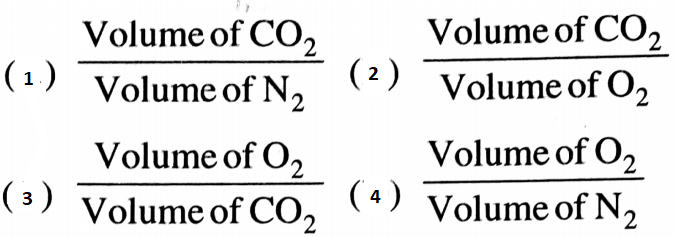
Answer: 2.
Question 26. Respiration is controlled by :
- Medulla oblongata
- cerebellum
- hypothalamus
- cerebrum.
Answer: 1. Medulla oblongata
Respiration In Plants NEET Notes
Question 27. R Q. of fat is :
- more than one
- one
- less than one
- infinite.
Answer: 3. less than one
Question 28. Which does not affect the oxyhaemoglobin curve :
- high O2 and low CO2
- high body temperature
- high O2 and high haemoglobin
- high pH.
Answer: 3. high O2 and high haemoglobin
Question 29. After taking a long deep breath we do not respire for some seconds due to :
- More CO2 in blood
- More O2 in the blood
- less CO2 in blood
- less O2 in blood.
Answer: 1. More CO2 in blood
Question 30. Formation of non-functional methaenoglobin causes blue-baby syndrome. This is due to :
- excess of arsenic concentration in drinking water
- excess of nitrates in drinking water
- deficiency of iron in food
- increased methane content in the atmosphere.
Answer: 2. an excess of nitrates in drinking water
Question 31. Maximum amount of oxygen is exchanged from the blood in the
- capillaries-surrounding tissue cells
- arteries of the body
- left auricle of the heart
- capillaries surrounding the alveoli.
Answer: 1. capillaries-surrounding tissue cells
Question 32. Match the disorders given in Column 1 with symptoms under Column 2. Choose the answer which gives the correct combination of alphabets with numbers.
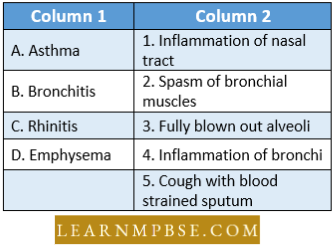
- A = 4. B = 2. C = 5. D = 1
- A = 5. B = 3. C = 2, D = 1
- A = 3. B = 1. C = 5. D = 4
- A = 2. B = 4. C = 1. D = 3.
Answer: 4. A = 2. B = 4. C = 1. D = 3
Question 33. If R.Q is 0.6 in respiratory metabolism, it would mean that
- Carbohydrates are used as respiratory substrates.
- Organic Acids are used as respiratory substrates.
- The oxidation of the respiratory substrate consumed more oxygen than the amount of CO2 released
- The oxidation of the respiratory substrate consumed less oxygen than the amount of CO2 released
Answer: 3. The oxidation of the respiratory substrate consumed more oxygen than the amount of CO2 released
Question 34. Statements
A. Carbonic anhydrase is present in the erythrocytes
B. In erythrocytes the carbon dioxide combines with water and is transported.
- statement A is correct and is responsible for statement B
- statement A is not correct but statement B is correct
- both statements A and B are wrong
- statement A is correct but not involved in statement B
- statement A is correct and statement B is wrong.
Answer: 1. statement A is correct and is responsible for statement B
Question 35. Which of the following statements are true/false?
- The blood transports CO2 comparatively easily because of its higher solubility.
- Approximately 8.9% of CO2 is transported being dissolved in the plasma of blood
- The carbon dioxide produced by the tissues, diffuses passively into the bloodstream and passes into red blood corpuscles and reacts with water to form H2C3.
- The oxyhaemoglobin (HbO2) of the erythrocytes is basic.
- The chloride ions diffuse from plasma into the erythrocytes to maintain ionic balance.
- 1, 3 and E are true, 2 and 4 are false
- 1, 3 and E are false, B and D are true
- 1, 2 and D are true, 3and 5 are false
- 1, 2 and D are false, 3 and E are true
- 1, 2 and 3 are true, and 4 and 5 are false.
Answer: 1
Glycolysis And Krebs Cycle NEET Study Material
Question 36. People living at sea level have around 5 million RBCs per cubic millimetre of their blood whereas those living at an altitude of 5400 metres have around 8 million.
- people eat more nutritive food, therefore more RBCs are formed
- people get pollution-free air to breathe and more oxygen is available
- atmospheric O2 level is less and hence more RBCs are needed to absorb the required amount of O2 to survive
- there is more UV radiation which enhances RBC production.
Answer: 3. atmospheric O2 level is less and hence more RBCs are needed to absorb the required amount of O2 to survive
Question 37. Column A represents diseases and Column B represents their symptoms, which of the following pairs is the correct match for them?
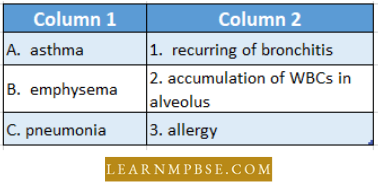
- A- (3), B – (1), C – (2)
- A- (2), B – (1), C – (3)
- A- (3), B – (1), C – (1)
- A- (2), B – (1), C – (1)
Answer: 1. A- (3), B – (1), C – (2)
Question 38. Maximum amount of oxygen is lost from the blood in the
- capillaries surrounding the tissue cells
- arteries of the body
- capillaries surrounding the alveoli
- left auricle of the heart.
Answer: 3. capillaries surrounding the alveoli
Question 39. Identify the correct statement with reference to the transport of respiratory gases by blood.
- Haemoglobin is necessary for the transport of carbon dioxide and carbonic anhydrase for the transport of carbon dioxide
- Haemoglobin is necessary for the transport of oxygen and carbonic anhydrase for transport of carbon dioxide
- Only oxygen is transported by blood
- Only carbon dioxide is transported by blood.
Answer: 2. Haemoglobin is necessary for the transport of oxygen and carbonic anhydrase for the transport of carbon dioxide
Question 40. The figure given below shows a small part of the human lung where the exchange of gases takes place. In one of the options given below, one part A, B, C or D is correctly identified along with its function.

Options :
- C: arterial capillary – passes oxygen to tissues
- A: alveolar cavity – the main site of exchange of respiratory gases
- D: capillary wall – exchange of O2 and CO2 takes place here.
- B: red blood cell – transport of CO2 mainly.
Answer: 2. A: alveolar cavity – the main site of exchange of respiratory gases
Question 41. The ‘blue baby’ syndrome results from :
- excess of dissolved oxygen.
- excess of TDS (total dissolved solids)
- excess of chloride
- methenoglobin.
Answer: 4. methemoglobin
Question 42. Which one of the following statements is incorrect?
- In insects, circulating body fluids serve to distribute oxygen to tissues
- The residual air in the lung slightly decreases the efficiency of respiration in mammals
- The principle of counter-current flow facilitates efficient respiration in the gills of fishes
- The presence of non-respiratory air sacs increases the efficiency of respiration in birds.
Answer: 1. In insects, circulating body fluids serve to distribute oxygen to tissues
Question 43. Arrange the following in the order of increasing volume :
- Tidal volume
- Residual volume
- Inspiratory reserve volume
- Vital capacity.
Choose The Correct Option
- 1 < 3 < 2 < 4
- 1 < 2 < 3 < 4
- 1 < 4 < 3 < 2
- 1 < 4 < 2 < 3.
Answer: 2. 1 < 2 < 3 < 4
Question 44. A large proportion of oxygen is left unused in the human blood even after its uptake by the body
- Acts is a reserve during muscular exercise
- Raises the Pco2 of blood to 75 mm of Hg
- Is enough to keep oxyhaemoglobin saturation at 96%
- Helps in releasing more O2 to the epithelial tissues.
Answer: 3. Is enough to keep oxyhaemoglobin saturation at 96%
Electron Transport Chain In Plants NEET Important Points
Question 45. Which of the following factors raises the Pco2 of value and shifts the HbO2, dissociation curve to the right and vice versa?
- Rise in Pco2
- Fall in temperature
- Rise in H+ ions (= fall in pH)
- Fall in d iphospho glyceric acid.
Answer codes :
- A and B are correct
- B and D are correct
- A and D are correct
- A, B and C are correct.
Answer: A and D are correct
Question 46. “Increased asthmatic attacks in certain seasons are related to :
- low temperature
- inhalation of seasonal pollen
- hot and humid environment
- eating fruits preserved in tin containers.
Answer: 2. inhalation of seasonal pollen
47. Two friends are eating together at a dining table. One of them suddenly starts coughing while swallowing some food. This coughing would have been due to improper movement of :
- Epiglottis
- Diaphragm
- Neck
- Tongue.
Answer: 1. Epiglottis
Question 48. Oxygen toxicity is related with :
- blood poisoning
- collapse of alveolar walls
- failure of ventilation of lungs
- Both 1 and 2
Answer: 3. failure of ventilation of lungs
Question 49. Which of the following statements is not true?
- A partial pressure of oxygen in deoxygenated blood is 40 mm Hg.
- The partial pressure of oxygen in oxygenated blood is 95 mm Hg
- The partial pressure of carbon dioxide in deoxygenated Blood is 95 mm Hg.
- The partial pressure of oxygen in the alveolar air is 104 mm kg
- The partial pressure of carbon dioxide in the Match the items in Column I with Column II and choose the correct option
Answer: 3. The partial pressure of carbon dioxide in deoxygenated Blood is 95 mm Hg.
Question 50. Match the items in Column I with Column II and choose the correct option
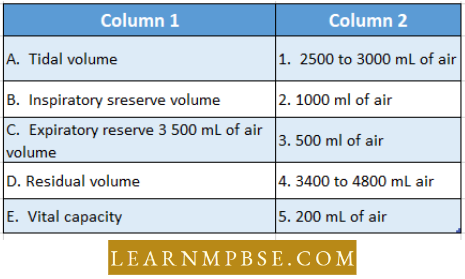
- A = 3, B = 4, C = 2, D = 1, E = 5
- A = 3, B = 1, C = 4, D = 5, E = 4
- A = 3, B = 1, C = 2, D = 5, E = 4
- A = 5, B = 4, C = 2, D = 1, E = 2
- A = 4, B = 3, C = 2, D = 1 E = 5.
Answer: 3. A = 5, B = 4, C = 2, D = 1, E = 2
Question 51. The functions of surfactant are/are :
- to reduce tire surface tension on the alveoli
- maintaining the stable si/e of the alveoli
- facilitating lung expansion
- all of the above.
Answer: 4. all of the above
Question 52. The number of KBCs in man increases if he lives at a higher altitude because :
- there is less oxygen in mountains
- there is more oxygen in the mountains
- There are no germs in the air in the mountain
- More heat is required to be produced in the body to keep warm.
Answer: 1. there is less oxygen in mountains
Question 53. About 97% of O2. is transported by RBC. The remaining 5% is :
- dissolved in plasma and transported
- remains in lungs
- attached to cell membranes
- inside the mitochondria
- in peroxisomes.
Answer: 1. Dissolved in plasma and transported
Question 54. What is the vital capacity of our lungs?
- Total lung capacity minus residual volume
- Inspiratory reserve volume plus tidal volume
- Total lung capacity minus expiratory reserve volume
- Inspiratory reserve volume plus expiratory reserve volume.
Answer: 4. Inspiratory reserve volume plus expiratory reserve volume
55. Which two of the following changes (a-d) usually tend to occur in the plain dwellers when they move to high altitudes (3,500 m or more)?
- Increase in red blood cell size
- Increase in red blood cell production
- Increased breathing rate
- Increase in thrombocyte count.
Changes occurring are :
- C and D
- A and D
- A and B
- B and C.
Answer: 4. B and C
Question 56. Listed below are four respiratory capacities (a-d) and four jumbled respiratory volumes of a normal human adult :
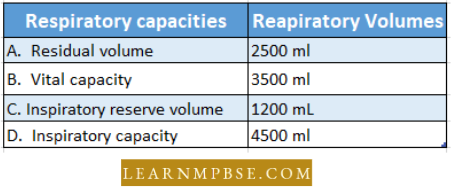
Which one of the following is the correct matching of two opacities and volumes?
- 1200 mL,2500 mL
- 3500 mL,1200 mL
- 4500 mL,3500 mL
- 2500 mL, 4500 mL
Answer: 2. 3500 mL,1200 mL
Question 57. Which one of the following is the correct statement for respiration in humans?
- Neural signals from the pneumotoxic centre in the pons region of the brain can increase the duration of inspiration.
- Workers in grinding and stone-breaking industries may suffer from lung fibrosis
- About 90% of carbon dioxide (CO2) is carried by haemoglobin as carabinero-haemoglobin.
- Cigarette smoking may lead to inflammation of the bronchi.
Answer: 2. Workers in grinding and stone-breaking industries may suffer from lung fibrosis
Question 58. The volume of Anatomical dead space air is normal.
- 230 ml
- 210 ml
- 190 ml
- 150 ml
Answer: 4. 150 ml
Question 59. Choose the right sequential phenomena among the following during the delivery of O2 from blood to tissue.
- P: Absorption hr CO2 by the blood.
- Q: Reaction of absorbed CO2 with H2O to form H2CO3 with RBC and its conversion into H+ and HCO3 ions.
- R: Reaction of absorbed CO2 with H2Oin plasma to form H2CO3 and its conversion into H+ and HC3 ions.
- S: Combination of H+ with heme portion of Hb02 to release O2.
- T: Combination of HCO3 with heme portion HbO2 to form reduced haemoglobin and release of O2.
Choose The Correct option
- P, Q, T
- P, R, S
- P, Q, S
- P, R, T.
Answer: 3. P, Q, S
Question 60. The figure shows a diagrammatic view of the human respiratory system with labels 1 2, 3 and 4. Select the option which gives correct identification and main function and/or characteristics.
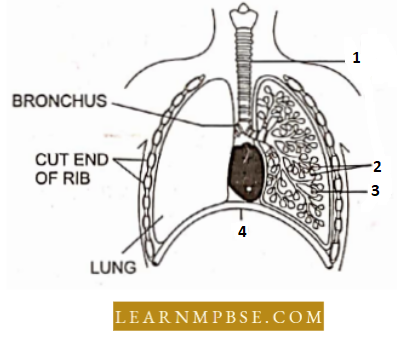
- Pleural membrane-surround ribs on both sides to provide cushion against rubbing.
- Alveoli-thin walled vascular bag-like structures for exchange of gases.
- The lower end of the lungs-diaphragm pulls it down during inspiration
- Trachea-long tube supported by complete cartilaginous rings for conducting inspired air.
Answer: 2. Alveoli-thin walled vascular bag-like structures for the exchange of gases
Question 61. The figure shows the schematic plan of blood circulation in humans with Iaoels 1 to 4. Identify the label and give its functions.
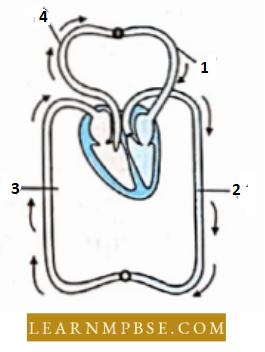
- Pulmonary artery – takes blood from heart to lungs, PO2 = 90mm Hg
- Vena Cuva – takes blood from body parts to the right auricle, PCO2 = 45mm Hg
- Dorsal aorta – takes blood from Heart to body Part PO2 = 95 mm Hg
- Pulmonary vein – takes impure blood from body parts, PO2 = 60 mm Hg
Answer: 2. Vena Cuva – takes blood from body parts to the right auricle, PC02 = 45mm Hg

